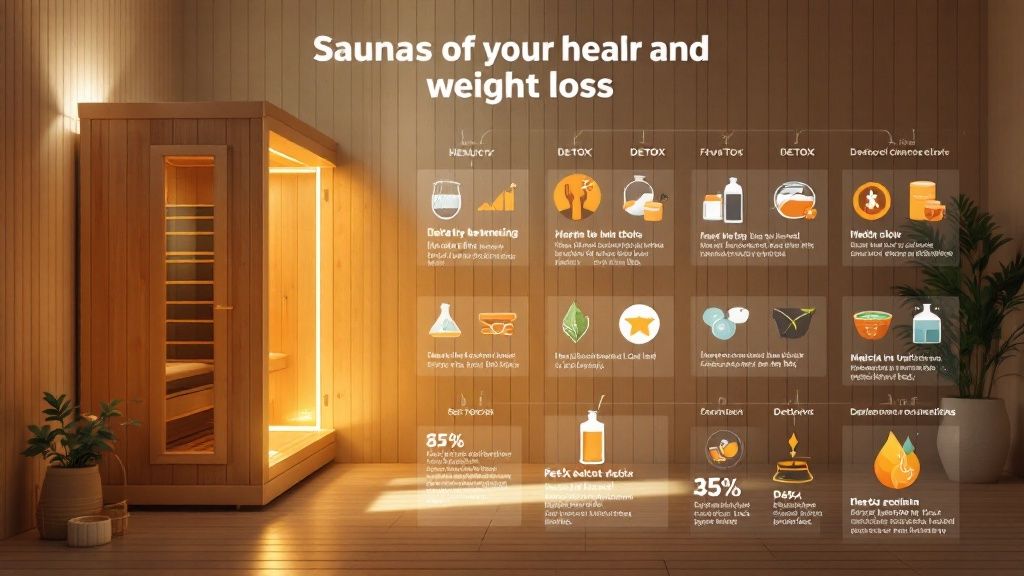Sauna for Weight Loss: Transform Your Health
- Sauna Tracker

- Mar 8
- 11 min read
Updated: Jul 8
The Real Science Behind Sauna Weight Effects

Stepping into a sauna initiates a cascade of physiological responses within the body. One of the most immediate and noticeable effects is increased sweating, a natural cooling mechanism triggered by the elevated temperature. This brings us to the often-misunderstood topic of water weight.
Many people associate saunas with weight loss, primarily due to this loss of water weight. Studies show individuals can lose around 0.65 kilograms of fluid during a sauna session. Those with a higher body mass and surface area tend to lose more water weight because they sweat more. It's important to remember this weight loss is temporary. Once rehydrated, the lost water weight returns.
Saunas can also elevate heart rate, potentially contributing to a slight increase in calorie burn. However, this effect is minimal compared to the calorie expenditure of a proper workout. Do Saunas Help You Lose Weight? explains this temporary weight loss in detail. Seeing the number on the scale decrease after a sauna session can be encouraging, but it's important to understand it doesn't represent a change in body fat.
Understanding the Cardiovascular Response
Beyond water weight, saunas affect the cardiovascular system. The heat causes an increase in heart rate, much like moderate exercise. This elevated heart rate results in a small increase in calorie expenditure. While a typical sauna session burns some calories, it's not a substitute for the calorie burn achieved through exercise. For more related articles, you can explore our blog post sitemap.
Another cardiovascular effect is vasodilation, or the widening of blood vessels. Vasodilation improves blood flow and circulation, contributing to a sense of relaxation and well-being. However, it’s important to understand this doesn’t directly translate to fat loss. While cardiovascular and metabolic changes occur during a sauna session, their direct impact on long-term weight loss is limited.
Separating Fact from Fiction
It's crucial to differentiate between the realities and misconceptions surrounding sauna use for weight loss. While saunas can induce a temporary decrease in water weight and slightly elevate calorie expenditure, they are not a quick fix for weight loss. The most significant and lasting changes in body composition come from a balanced diet combined with regular exercise.
Let's take a closer look at the specific physiological effects of sauna use on weight:
The following table details the impact of sauna sessions on weight:
Sauna Session Effects on Weight
Physiological Effect | Duration | Weight Impact | Notes |
|---|---|---|---|
Increased Sweating | Throughout session | Temporary water weight loss (approx. 0.65 kg) | Returns with rehydration |
Increased Heart Rate | Throughout session | Minor increase in calorie expenditure | Not comparable to exercise |
Vasodilation | Throughout session | No direct weight impact | Improves circulation |
This table illustrates how sauna use influences weight, highlighting the temporary nature of water weight loss and the minimal impact on calorie burning. While these physiological responses offer other health benefits, they aren't primary drivers of weight loss. Sustainable weight management relies on a holistic approach that includes diet and exercise.
Beyond Water Weight: Fat Loss Research Revealed

We've already seen how sauna use can lead to a temporary decrease in water weight. But the real question is: can saunas help with actual fat loss? This is where the latest research on heat exposure and body composition gets really interesting.
Exploring the Science of Heat and Fat Loss
Numerous studies are exploring the link between sauna use and fat loss. Researchers are investigating several possible mechanisms. One focus area is the role of heat shock proteins (HSPs). These proteins are produced by the body in response to stress, like heat stress, and may influence metabolism.
Scientists are also studying how sauna use relates to brown fat activation. Brown fat, unlike white fat, burns calories for heat. Its activation could help with weight loss. For more information on related topics, check out our guide on blog categories.
A Binghamton University study offers compelling evidence. Participants who used an infrared sauna three times a week for 45 minutes over 16 weeks saw a noticeable reduction in body fat. Some lost up to 4% of their body fat. Intriguingly, those using the sauna later in the day saw better results, hinting that timing matters. You can find the complete study here. This study highlights the potential of saunas to contribute to fat loss, especially as part of a healthy lifestyle.
Infrared vs. Traditional Saunas: Investigating Differences
Beyond the basic science of heat exposure, researchers are comparing the effects of infrared saunas and traditional saunas on fat loss. Infrared saunas use infrared lamps to heat the body directly, while traditional saunas heat the surrounding air.
This key difference affects how deeply heat penetrates the body, potentially influencing fat loss. More research is needed to fully grasp the specific benefits of each type. However, both provide heat exposure, the key factor in potential fat loss.
The Current Research Landscape and Future Directions
While the current research is promising, more is needed to solidify these findings and explore the long-term effects of sauna use on fat loss. Many of the existing studies are small-scale. Future research will likely explore how to optimize sauna use for weight management, such as the ideal temperature, duration, and frequency.
This exciting area of research holds much promise for discovering new weight management strategies. By staying informed about the latest scientific findings, you can make smart choices about using saunas as part of your weight loss journey.
Traditional vs. Infrared: Which Delivers Better Results
If you're considering a sauna for weight loss, the type of sauna you choose makes a real difference. The two primary options are traditional saunas and infrared saunas. These saunas have distinct heating methods, impacting your body and potentially influencing your weight management results.
Heating Mechanisms: A Tale of Two Saunas
Traditional saunas heat the air around you. They use heated rocks or a wood-burning stove to raise the sauna's air temperature, which then warms your body. Infrared saunas, conversely, use infrared lamps. These lamps heat your body directly, with the infrared waves penetrating deeper into your tissues. This core difference affects how your body reacts to the heat.
Body Penetration and Physiological Responses
The varying heating methods result in different levels of body penetration. Infrared saunas, with their direct heat, penetrate deeper than the surface-level warmth of traditional saunas. This deeper penetration can lead to a more intense sweat at lower temperatures. Infrared saunas usually operate between 120-140°F (49-60°C), while traditional saunas reach higher temperatures, typically 150-195°F (66-91°C). This means you can achieve a similar sweat level in an infrared sauna without the extreme heat of a traditional one.
Choosing the Right Sauna For Your Weight Loss Goals
Which sauna reigns supreme for weight loss? Both offer potential advantages. Traditional saunas provide a high-intensity heat experience, which some find invigorating and detoxifying. Infrared saunas, on the other hand, deliver a gentler, deeper heat that may be better for those sensitive to high temperatures. You can explore our sitemap for further details.
To help you decide, let's look at a comparison of the two sauna types:
To help you compare and contrast the two sauna types for your weight loss journey, we've created a handy table summarizing the key differences and similarities:
Traditional vs. Infrared Sauna Comparison This table compares traditional and infrared saunas across key factors relevant to weight loss goals.
Feature | Traditional Sauna | Infrared Sauna | Weight Loss Implications |
|---|---|---|---|
Heating Method | Heats the air | Heats the body directly | |
Temperature Range | 150-195°F (66-91°C) | 120-140°F (49-60°C) | |
Sweat Depth | Surface level | Deeper penetration | Infrared may induce a more intense sweat at lower temperatures |
Calorie Burn | Moderate | Moderate | Both contribute to calorie burn, but not a significant amount compared to exercise |
Experience | Intense, dry heat | Gentle, deeper heat | Choose based on personal preference and heat tolerance |
Key Insights:
While both sauna types can contribute to calorie burn, it's essential to remember that the effect is minimal compared to exercise. The most significant factor in choosing between the two is your personal preference and heat tolerance.
Ultimately, the "best" sauna for weight loss is subjective. It depends on individual preferences, how well you tolerate heat, and your specific goals. Other factors, such as detoxification and post-workout recovery, might also influence your decision. Trying both types can help you determine which best fits your needs and supports your weight loss efforts.
Strategic Sauna Protocols That Maximize Results

Turning casual sauna sessions into a powerful tool for weight management means understanding the key factors at play. These include temperature, duration, frequency, and timing relative to other activities like eating and working out. By fine-tuning these elements, you can create a personalized sauna protocol tailored to your own goals and physical condition. For further information, check out this resource: How to master your sauna experience.
Temperature Ranges and Exposure Duration
If you're new to saunas, start slowly. Begin with lower temperatures and shorter sessions, gradually increasing both as your body adjusts to the heat. A good initial target is 15-20 minutes at a temperature that makes you sweat comfortably without feeling overwhelmed. Experienced sauna users can handle higher temperatures for longer, but always pay attention to your body's signals and avoid pushing past your limits. This gradual approach allows for safe adaptation to the heat stress, maximizing the benefits and minimizing potential risks.
Weekly Frequency and Timing
For weight loss, aim for 2-3 sauna sessions per week. Going more often could lead to dehydration if you're not careful about fluid intake. When you schedule your sessions can also make a difference. Some research indicates that later in the day might be more beneficial for fat loss, but more investigation is needed. Think about combining your sauna time with cardio workouts to boost the overall effect. Find more detailed statistics here.
It's important to remember that while saunas can support temporary weight loss, they aren't a magic bullet. Sustainable weight management requires a balanced diet and consistent exercise. Adding sauna sessions to your cardio routine can enhance weight loss by burning more calories and promoting detoxification through sweat. Staying well-hydrated is crucial, and consulting a healthcare professional is always recommended, especially if you're new to saunas.
Pre and Post-Sauna Nutrition and Hydration
Proper nutrition and hydration are essential for a safe and effective sauna experience. Before your session, have a light meal and make sure you're properly hydrated. Steer clear of alcohol and heavy meals, which can increase dehydration risk. During and after your sauna session, replenish lost fluids with water or electrolyte drinks.
Measuring Meaningful Progress
While the scale can give you a general idea of weight changes, it's important to look at the bigger picture. Pay attention to how your clothes fit, your energy levels, and your overall well-being. These subjective indicators often reflect the positive changes happening inside your body from regular sauna use more accurately. Remember, consistent and strategic sauna use, combined with a healthy lifestyle, is the key to achieving your weight management goals.
Heat Plus Exercise: The Ultimate Synergistic Approach

Many athletes and fitness enthusiasts are incorporating sauna use into their training to improve their body composition. This exploration delves into the science behind combining heat exposure with exercise and provides practical protocols for adding sauna sessions to your workout routine. Interested in maximizing your sauna experience? Check out this resource: How to master your sauna experience.
Metabolic Advantages of Combining Heat and Exercise
Combining sauna use with exercise offers several potential metabolic benefits. The elevated heart rate in a sauna mirrors the cardiovascular response to moderate exercise. This can result in a slight increase in calorie expenditure. In addition, heat exposure can influence hormone profiles, potentially affecting recovery and muscle growth.
Pre-Workout Sauna Sessions: Priming Your Body
Some studies indicate that pre-workout sauna sessions might prepare the body for increased fat utilization during exercise. The heat can increase blood flow to muscles and raise core body temperature, potentially optimizing the environment for burning fat. Further research is needed to fully understand the impact of pre-workout sauna use.
Post-Workout Heat Therapy: Recovery and Hormone Effects
Post-workout sauna sessions may influence both recovery and hormone profiles. The heat can relax muscles and reduce post-workout soreness, promoting faster recovery and more frequent training. Heat exposure might also influence the release of growth hormone, potentially supporting muscle growth and repair.
Exercise Types and Synergistic Effects
Different exercise types may yield varied synergistic effects when combined with sauna use. Pairing sauna sessions with strength training could enhance muscle recovery and growth. Combining sauna use with HIIT (High-Intensity Interval Training) might increase calorie burn and improve cardiovascular fitness. Likewise, using the sauna after endurance work could reduce muscle fatigue and promote relaxation.
Practical Protocols for Integration
Here are some practical ways to integrate sauna sessions with your workout routine:
Strength Training: A 15-20 minute sauna session post-workout can aid muscle recovery.
HIIT: A shorter 10-15 minute sauna session after HIIT can help extend calorie burn and promote relaxation.
Endurance Work: A 20-minute sauna session after endurance training may reduce muscle soreness and support recovery.
These are general guidelines. Individual responses to heat and exercise differ, so adjust these protocols based on your needs and tolerance. Begin with shorter sessions and gradually increase the duration as your body adapts. Prioritize hydration by drinking plenty of water before, during, and after sauna use.
By strategically combining heat exposure with your workouts, you can potentially enhance your body composition goals and optimize your overall fitness. Remember that consistent exercise and a balanced diet are still vital for long-term success.
Essential Safety Practices for Sustainable Results
Sauna use offers potential benefits for weight loss, but safety should always be your top priority. Understanding how heat affects your body and following evidence-based guidelines are crucial for maximizing the benefits and minimizing the risks.
Hydration and Electrolyte Balance
Profuse sweating is a hallmark of sauna use and contributes to temporary water weight loss. However, this fluid loss can lead to dehydration if not managed correctly. Drink plenty of water before, during, and after your sauna session. Consider electrolyte drinks like Gatorade or Powerade to replace essential minerals lost through sweat. Maintaining proper hydration isn't just about comfort; it's vital for preventing serious health complications.
Recognizing Heat Stress
Your body will communicate its limits. Heat stress can manifest as dizziness, nausea, headaches, and a rapid heart rate. If you experience any of these symptoms, leave the sauna immediately and cool down in a well-ventilated area. Ignoring these warning signs can lead to serious conditions like heat exhaustion or even heat stroke. Listen to your body and don't push past your comfort level.
Cardiovascular Considerations
Sauna heat increases your heart rate and can lower blood pressure. For most healthy individuals, these changes are temporary and present minimal risk. However, if you have pre-existing cardiovascular conditions, consult your doctor before using a sauna. The added strain on the cardiovascular system could worsen existing conditions. Understanding your personal health profile is key to safe sauna practices.
Medications and Health Conditions
Certain medications and health conditions require additional caution with sauna use. Some medications can affect your body's temperature regulation, increasing your susceptibility to heat stress. Certain health conditions, such as pregnancy, also necessitate special consideration. Consult your doctor for personalized advice if you have any underlying health issues or take regular medications. This ensures your sauna experience is both safe and tailored to your individual needs.
Gradual Progression and Heat Adaptation
Like any new activity, start slowly with sauna use. Begin with shorter sessions at lower temperatures, gradually increasing the duration and temperature as your body adapts. This allows your body to adjust to the heat stress, reducing the risk of adverse reactions. Think of it like a workout program; you wouldn't lift your maximum weight on your first day. Similarly, a gradual approach to sauna use allows your body to adjust safely and effectively.
When to Avoid Sauna Use
There are times when sauna use should be avoided entirely. Never use a sauna if you are feeling unwell, have a fever, or are under the influence of alcohol. These factors can increase your risk of dehydration and other complications. Prioritizing your health is essential, so listen to your body and avoid the sauna when it could pose a risk.
By following these essential safety practices, you can enjoy the potential weight loss and other health benefits of sauna use while minimizing any risks. Remember, your safety is paramount.
Ready to elevate your sauna experience and track your progress towards your wellness goals? Download Sauna Tracker now! Sauna Tracker is the perfect companion for optimizing your sauna sessions and monitoring your health metrics.
Article created using [Outrank](https://outrank.so)

.png)

